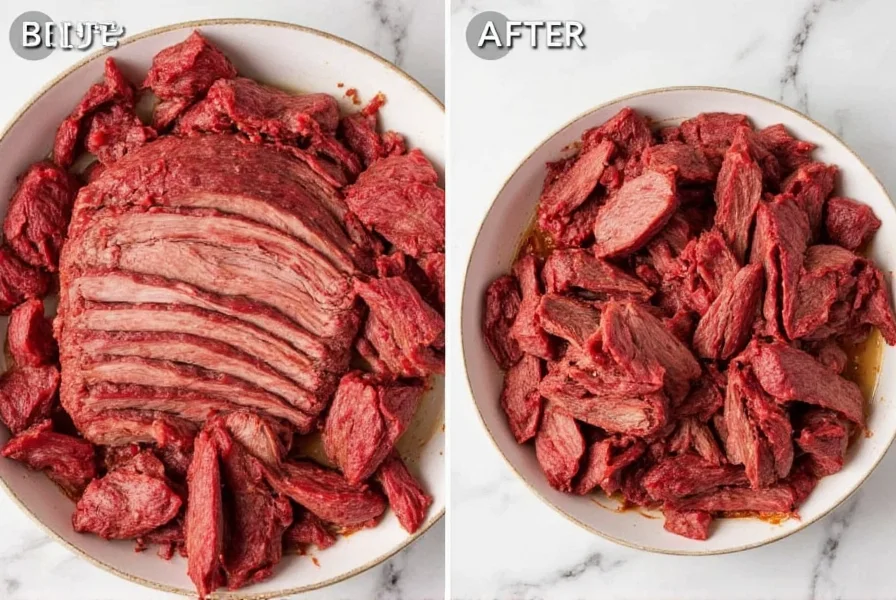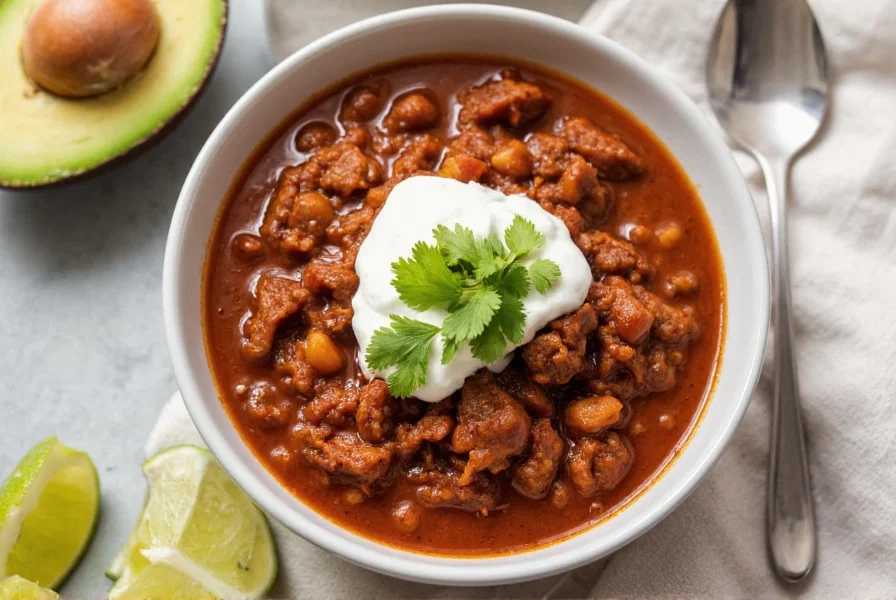When crafted properly, beef brisket chili represents the pinnacle of slow-cooked comfort food. Unlike conventional chili recipes that rely on ground beef or chuck roast, brisket's unique composition—featuring substantial marbling and connective tissue—transforms during the extended cooking process into melt-in-your-mouth tenderness while enriching the entire dish with gelatinous body and profound beef essence.
Why Brisket Outperforms Other Cuts for Chili
Brisket's anatomical position on the cow (the lower chest area) subjects it to constant use, developing dense muscle fibers and abundant collagen. This characteristic, often considered a challenge for quick-cooking methods, becomes a tremendous advantage for chili. As the brisket simmers for hours, the collagen converts to gelatin at approximately 160°F (71°C), creating that signature rich mouthfeel that defines exceptional chili.
The fat content in brisket—particularly in the fattier "point" section—melts gradually, basting the meat internally while flavoring the entire pot. This natural marbling eliminates the need for additional fats that many chili recipes require. Professional pitmasters consistently choose brisket for championship chili competitions because of its ability to develop complex flavor compounds through the Maillard reaction during initial searing.

Essential Ingredients for Authentic Beef Brisket Chili
While regional variations exist, the foundation for exceptional brisket chili includes:
| Ingredient Category | Key Components | Professional Recommendation |
|---|---|---|
| Meat Selection | Brisket point (vs flat), optional short ribs | Use 3-4 lbs brisket point for optimal fat content |
| Chili Base | Ancho, guajillo, chipotle peppers | Toast dried peppers before blending for depth |
| Aromatics | Onion, garlic, celery | Caramelize slowly for sweetness without bitterness |
| Liquid | Beef stock, coffee, tomato | Use cold-brew coffee for acidity without bitterness |
| Spices | Cumin, oregano, smoked paprika | Bloom spices in fat before adding liquids |
Step-by-Step Brisket Chili Preparation
Follow this professional method for consistently outstanding results:
- Prep the brisket: Trim excess hard fat but retain 1/4-inch coverage. Cut into 1.5-inch cubes, keeping grain direction consistent for even cooking.
- Sear properly: Heat cast iron to smoking point. Sear brisket in small batches without crowding—this develops crucial flavor compounds through the Maillard reaction.
- Build flavor foundation: After removing meat, sauté onions until deeply caramelized (25-30 minutes), then add garlic and spices to toast in rendered fat.
- Hydrate dried chilies: Toast ancho and guajillo peppers briefly, then steep in hot water with coffee for 20 minutes before blending into smooth paste.
- Slow cook: Combine all ingredients in heavy pot. Simmer uncovered for 3-4 hours at 180-200°F (82-93°C), stirring occasionally. The brisket should pull apart easily with forks.
- Final reduction: Increase heat to medium-low for 20-30 minutes to concentrate flavors and achieve ideal thickness without compromising tenderness.
Avoiding Common Brisket Chili Mistakes
Even experienced cooks make these critical errors when preparing beef brisket chili:
- Insufficient searing time: Rushing the sear creates steamed rather than caramelized meat. Proper searing requires 2-3 minutes per side with adequate space between pieces.
- Over-reducing liquid: Adding insufficient liquid leads to dry meat before collagen breaks down. Maintain liquid level 1 inch above meat throughout cooking.
- Incorrect temperature: Boiling destroys delicate flavor compounds. Maintain a bare simmer—bubbles should barely break the surface.
- Skipping the rest period: Allowing chili to rest overnight lets flavors fully integrate and improves texture dramatically.

Traditional Serving Methods and Pairings
In Central Texas, where brisket chili traditions run deep, the dish is traditionally served in wide-rimmed bowls with specific accompaniments that enhance rather than mask the complex flavors:
- Crumbled queso fresco (not shredded cheddar) for subtle saltiness
- Freshly squeezed lime wedges to brighten rich flavors
- Finely chopped white onion for texture contrast
- Warm cornbread served on the side for dipping
- Ice-cold Mexican lager to cut through richness
For authentic presentation, serve in pre-warmed ceramic bowls to maintain ideal serving temperature throughout the meal. The ideal brisket chili should have a thick but pourable consistency—able to coat the back of a spoon without immediately running off.
Storage and Reheating for Maximum Flavor
Brisket chili improves dramatically with proper storage techniques. Follow these professional guidelines:
- Cool to 70°F (21°C) within 2 hours of cooking to prevent bacterial growth
- Store in airtight containers with minimal headspace to reduce oxidation
- Refrigerate for up to 5 days or freeze for 6 months
- Reheat gently over medium-low heat, adding small amounts of broth if needed
- Always bring to 165°F (74°C) internal temperature before serving
Professional kitchens often prepare brisket chili two days in advance, as the collagen continues to break down during refrigeration, creating an even richer texture. The fat solidifies on top when chilled—simply remove this layer before reheating for optimal texture.
Regional Variations Worth Exploring
While Texas-style brisket chili remains the gold standard, these regional adaptations offer distinctive flavor profiles:
- Smoked brisket chili: Incorporate 25% of the liquid as smoked beef bone broth and add mesquite wood chips during final reduction
- Cincinnati-style: Add 1 tablespoon unsweetened cocoa powder and a splash of apple cider vinegar for depth
- New Mexico variation: Replace tomato products with roasted red peppers and use Hatch green chilies
- Beer-braised version: Substitute 2 cups of dark Mexican lager for equal parts beef stock
Frequently Asked Questions
What cut of brisket is best for chili?
The brisket point (second cut) with its higher fat content and marbling is ideal for chili. This section contains more intramuscular fat and connective tissue that breaks down during slow cooking, creating superior texture and flavor compared to the leaner brisket flat. Professional chili makers typically use 3-4 pounds of point cut for optimal results.
How long should beef brisket chili cook?
Beef brisket chili requires 3-4 hours of gentle simmering at 180-200°F (82-93°C) to properly break down the collagen into gelatin. The brisket should become fork-tender but not disintegrate. Rushing the process by boiling will result in tough, stringy meat. Many professional chefs recommend an additional 20-30 minutes of reduction after the meat is tender to concentrate flavors.
Can I make brisket chili in a pressure cooker?
While possible, pressure cooking brisket for chili sacrifices flavor development. The Maillard reaction and slow collagen conversion that create complex flavors in traditional methods happen differently under pressure. If using a pressure cooker, sear thoroughly first, then cook at high pressure for 60-75 minutes followed by natural release. However, the texture and depth will differ from slow-simmered versions.
Why does my brisket chili turn out dry?
Dry brisket chili typically results from insufficient liquid during cooking or excessive reduction. Maintain liquid level at least 1 inch above meat throughout cooking. Brisket requires ample liquid to transform collagen into gelatin—without enough moisture, the meat dries out before tenderizing. Also ensure you're not boiling vigorously, which accelerates liquid evaporation.











 浙公网安备
33010002000092号
浙公网安备
33010002000092号 浙B2-20120091-4
浙B2-20120091-4